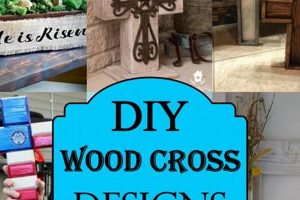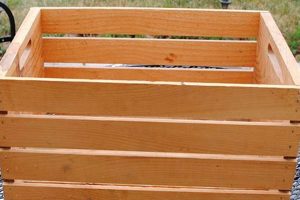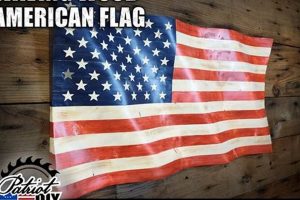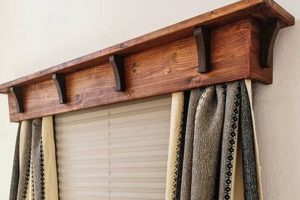A self-constructed wooden structure, typically an archway, created for use as a decorative element at a wedding ceremony or reception. These handmade constructions often serve as a focal point, framing the couple during the exchange of vows or providing a backdrop for photographs. For instance, a couple might choose to build a simple A-frame arch adorned with flowers and fabric, customized to match their wedding theme.
The creation of such a feature offers numerous advantages, including cost savings compared to renting or purchasing a pre-made alternative. It allows for complete customization, ensuring the piece perfectly complements the wedding’s style and color palette. Historically, arches have symbolized a gateway to a new beginning, making their presence at a wedding particularly meaningful. The act of building the structure together can also be a collaborative and memorable experience for the couple or their loved ones.
The subsequent sections will delve into the specific materials required, detailed construction methods, design considerations, and safety precautions necessary for successfully undertaking a building project of this nature.
Guidance for Wooden Wedding Arch Construction
The following recommendations aim to facilitate a safe and successful construction of an arch, emphasizing structural integrity and aesthetic appeal.
Tip 1: Material Selection: Opt for seasoned lumber to minimize warping or cracking post-construction. Cedar or redwood offer natural resistance to decay, extending the lifespan of the arch.
Tip 2: Precise Measurements: Accurately measure and cut all components to ensure a structurally sound and visually balanced arch. Inaccurate measurements can compromise stability.
Tip 3: Secure Joinery: Employ robust joinery techniques, such as mortise-and-tenon or reinforced screws with wood glue, to create strong and lasting connections between structural elements.
Tip 4: Adequate Bracing: Incorporate diagonal bracing to enhance the arch’s resistance to lateral forces, preventing swaying or collapse, particularly in windy conditions.
Tip 5: Stable Base Design: Design a stable base that adequately supports the arch’s weight and prevents tipping. Consider using weighted bases or anchoring the arch to the ground.
Tip 6: Consider Portability: If relocation is desired, design the arch in modular sections for simpler transport and re-assembly at the venue.
Tip 7: Surface Treatment: Apply a protective sealant or stain to preserve the wood’s appearance and prevent damage from weather exposure, especially if the arch will be used outdoors.
Adhering to these guidelines will contribute to the creation of a durable, visually appealing, and safe structure for the wedding celebration.
The subsequent section provides a concluding summary of the advantages and long-term value associated with this type of handcrafted wedding dcor.
1. Structural Integrity
Structural integrity is a paramount concern in any construction project, particularly when considering a self-built wooden arch intended for a wedding. It represents the arch’s ability to withstand applied loads and environmental stressors without deformation or collapse. The implications of inadequate structural integrity range from minor aesthetic flaws to catastrophic failure, potentially causing injury. The selection of appropriate wood types, the execution of robust joinery, and the implementation of adequate bracing are all determinants of the structure’s capacity to bear weight and resist external forces, such as wind.
The connection between structural integrity and the success of a wooden wedding arch is direct. A poorly constructed arch presents a safety hazard and detracts from the event’s aesthetic appeal. For example, an arch built with green, unseasoned wood is likely to warp and crack as it dries, compromising its stability. Similarly, inadequate joinery, such as using insufficient screws or failing to properly glue joints, can lead to structural weakness. The effect of these deficiencies is a compromised arch, prone to swaying or even collapsing under its own weight, or when subjected to mild external forces. Proper planning, including accurate load calculations and selection of appropriate materials and construction methods, is critical for ensuring a stable and enduring structure.
In summary, structural integrity is not merely a technical consideration but a fundamental prerequisite for a safe and aesthetically pleasing wedding arch. Ignoring these principles introduces significant risks and undermines the overall success of the project. Emphasis on sound engineering practices, material selection, and meticulous construction techniques is essential for realizing a durable and safe wedding arch.
2. Material Selection
Material selection plays a pivotal role in the structural integrity, aesthetic appeal, and longevity of a wooden wedding arch constructed by an individual. The choices made directly impact the arch’s resistance to environmental factors, its visual harmony with the wedding theme, and its overall lifespan.
- Wood Type: Strength and Durability
The type of wood selected is fundamental. Softwoods, such as pine, offer affordability but may lack the inherent strength and rot resistance of hardwoods like oak or cedar. Pressure-treated lumber provides enhanced protection against decay but may present aesthetic limitations. The choice should balance structural requirements with desired appearance and budget constraints. For instance, a redwood arch offers natural beauty and weather resistance, while a pine arch might require additional sealant applications for protection.
- Fasteners: Corrosion Resistance and Strength
Fasteners used in construction, such as screws, nails, and bolts, must be chosen with consideration for both strength and corrosion resistance. Exterior-grade fasteners are essential to prevent rust and weakening of joints, particularly in outdoor settings. The size and type of fastener must be appropriate for the wood being used to ensure a secure and lasting connection. An example is selecting stainless steel screws for a cedar arch to prevent galvanic corrosion and maintain joint integrity over time.
- Adhesives: Weatherproof Bonding
Wood glue contributes significantly to joint strength and overall structural stability. Exterior-grade wood glue is crucial for resisting moisture and preventing joint separation due to weathering. The adhesive must be compatible with the selected wood type and fasteners. For instance, using a polyurethane adhesive on a redwood arch creates a waterproof bond that withstands temperature fluctuations and humidity.
- Finishes: Protection and Aesthetics
Surface finishes, including stains, sealants, and paints, protect the wood from moisture, UV radiation, and insect infestation, extending the arch’s lifespan. The choice of finish also influences the arch’s aesthetic appeal, allowing for customization to match the wedding theme. For example, a clear sealant preserves the natural wood grain of a cedar arch, while a painted finish allows for color customization to complement the wedding dcor.
These material considerations are interlinked and collectively determine the success of a build. The optimal selection balances structural needs, cost factors, desired aesthetics, and required longevity. Neglecting any of these aspects compromises the final outcome, potentially leading to structural instability or a decreased lifespan.
3. Design Customization
Design customization is a central tenet when constructing a wooden wedding arch independently. It represents the opportunity to tailor the structure to reflect personal preferences, complement the wedding’s aesthetic theme, and accommodate specific venue requirements. The extent of customization directly influences the arch’s visual impact and its integration within the overall event design.
- Dimensional Adjustments
Dimensional adjustments encompass modifications to the arch’s height, width, and depth. These adjustments allow the structure to fit seamlessly within the designated space, accommodate varying heights of the wedding party, and create a visually balanced focal point. For example, a taller arch may be suitable for an outdoor ceremony with ample space, while a narrower arch may be necessary for an indoor venue with limited room.
- Material Selection
The selection of materials extends beyond structural considerations to encompass aesthetic elements. Different wood types, finishes, and decorative accents contribute to the arch’s visual character. The choice of reclaimed wood, for instance, introduces a rustic element, while a painted finish allows for color coordination with the wedding’s palette. The integration of fabric drapes, floral arrangements, or lighting further enhances the arch’s design and creates a personalized aesthetic.
- Structural Modifications
Structural modifications involve altering the arch’s fundamental design. This may include incorporating curved elements, asymmetrical shapes, or integrated seating. Such modifications require careful planning and execution to ensure structural integrity is maintained. An example of a structural modification is the addition of a built-in platform for floral arrangements, creating a tiered visual effect.
- Thematic Integration
Thematic integration entails aligning the arch’s design with the wedding’s overarching theme. This may involve incorporating specific motifs, symbols, or cultural elements. A beach-themed wedding, for instance, may feature an arch adorned with seashells and driftwood, while a rustic wedding may utilize rough-hewn lumber and natural elements. The thematic integration strengthens the arch’s connection to the overall event design and creates a cohesive visual experience.
The various facets of design customization converge to enable the creation of a unique and meaningful focal point for the wedding ceremony. This inherent adaptability constitutes a significant advantage of pursuing the construction independently, facilitating a personalized expression that is often unattainable with pre-fabricated alternatives. The successful implementation of design customization enhances the aesthetic appeal, and the emotional resonance of the wedding experience.
4. Aesthetic Harmony
Aesthetic harmony, in the context of constructing a wooden wedding arch, refers to the cohesive integration of the arch’s design elements with the broader visual themes of the wedding. It is the successful synchronization of the arch’s form, materials, and decorative components with the venue’s environment, the wedding’s color palette, and the couple’s personal style. The absence of aesthetic harmony can result in a visually discordant element that detracts from the overall event, while its presence enhances the wedding’s ambiance and creates a unified and memorable experience.
The achievement of aesthetic harmony requires careful consideration of several factors. The arch’s dimensions must be proportional to the space, neither overwhelming nor appearing insignificant. The choice of wood, finish, and decorative accents should complement the wedding’s color scheme and style, whether rustic, modern, or traditional. For example, a rustic wedding held in a barn may feature an arch constructed from rough-hewn lumber adorned with wildflowers, while a modern wedding in an urban loft may utilize a sleek, minimalist arch with geometric accents. Furthermore, the arch’s design should not clash with the wedding attire or other key visual elements. Successfully implementing these considerations elevates the arch from a mere structure to an integral component of the wedding’s visual narrative.
In conclusion, aesthetic harmony is not merely an optional embellishment, but an essential element in the successful integration of a wooden wedding arch. It demands meticulous planning, thoughtful material selection, and a keen awareness of the wedding’s overarching aesthetic. By prioritizing aesthetic harmony, individuals can construct a wooden wedding arch that enhances the visual appeal of the ceremony and contributes to a cohesive and memorable wedding experience. Failing to consider this harmony introduces the risk of a visual disconnect, undermining the carefully curated atmosphere.
5. Cost-effectiveness
The construction of a wooden wedding arch offers a significant opportunity for cost reduction compared to rental or purchase options from commercial vendors. The primary driver of savings stems from the elimination of retail markups and service fees associated with external suppliers. Raw materials, such as lumber, fasteners, and finishes, can be acquired at wholesale prices or from local suppliers, offering a cost advantage. Furthermore, utilizing existing tools and skills minimizes expenses associated with specialized labor or equipment rental. The degree of cost-effectiveness is directly proportional to the resourcefulness of the builder and the simplicity of the arch’s design. For example, employing reclaimed wood and a straightforward A-frame design necessitates fewer materials and less labor than a complex, custom-designed arch constructed from premium lumber.
The economic advantages extend beyond initial material costs. A self-built arch can be disassembled and repurposed for future events or landscaping projects, increasing its long-term value. Conversely, rental options provide only temporary use, lacking residual value. The cost-effectiveness equation also factors in the potential for personalization. Adjustments to the arch’s dimensions, materials, and decorative elements can be implemented without incurring additional charges from external vendors. A couple might choose to incorporate readily available natural elements, such as branches and foliage, reducing the need for purchased floral arrangements, thus further lowering overall expenses. Diligent cost tracking and material sourcing are crucial to optimizing the economic benefits of constructing an arch.
In summary, pursuing a building strategy offers measurable financial advantages compared to conventional procurement methods. The extent of these benefits hinges on factors such as material selection, design complexity, and the builder’s skill level. Although a self-made project requires an initial investment of time and effort, the potential for long-term savings and personalized customization positions it as a viable, cost-effective alternative for couples seeking to minimize wedding-related expenses. However, it’s essential to accurately assess one’s capabilities and resource availability to ensure successful construction without compromising safety or aesthetic quality.
Frequently Asked Questions
The following addresses common inquiries concerning the construction, stability, and aesthetic considerations surrounding DIY wooden wedding arches. This information serves to clarify potential concerns and provide guidance for a successful project.
Question 1: What is the optimal wood type for maximum structural integrity?
Durable hardwoods, such as cedar, redwood, or oak, are generally preferred. These species exhibit superior resistance to rot, warping, and structural fatigue compared to softwoods. Pressure-treated lumber may be considered for enhanced longevity, particularly in humid environments.
Question 2: How can the arch be stabilized against wind and uneven ground?
A wide, stable base is paramount. Weighted base plates or ground anchors are recommended to prevent tipping. Diagonal bracing, strategically positioned, will enhance resistance to lateral forces, minimizing sway in windy conditions. Precise leveling during setup is essential on uneven terrain.
Question 3: What joinery techniques provide the most robust connections?
Mortise-and-tenon joints, reinforced with weatherproof adhesive and screws, offer exceptional strength and durability. Lap joints, similarly reinforced, can provide adequate stability for less demanding designs. Avoid relying solely on nails or staples for load-bearing connections.
Question 4: How should the wood be treated to prevent weathering and decay?
Application of a high-quality exterior-grade sealant or stain is crucial. This protects the wood from moisture, UV radiation, and insect infestation. Reapplication may be necessary periodically, depending on environmental conditions and the specific product used.
Question 5: What safety precautions must be observed during construction?
Eye protection, gloves, and appropriate respiratory protection are mandatory when cutting, sanding, or applying finishes. Ensure a stable work surface and follow all safety guidelines for power tools. Seek assistance when lifting heavy components.
Question 6: How can the arch be disassembled and transported easily?
Modular construction, utilizing bolted connections, facilitates disassembly and transport. Label all components clearly to ensure proper reassembly. Consider using a wheeled cart or trailer for larger sections. Secure all parts during transport to prevent damage.
These responses offer essential insights into the crucial considerations involved in this type of undertaking. Diligence in these areas is key to achieving satisfactory outcomes.
The subsequent section provides a concise overview of key considerations for successful project completion.
Conclusion
This exploration of the “diy wooden wedding arch” domain has illuminated critical facets of its design, construction, and long-term viability. Sound structural integrity, judicious material selection, aesthetic harmony, customization potential, and economic feasibility represent cornerstones of a successful endeavor. The provided guidelines and safety protocols underscore the importance of meticulous planning and execution.
Ultimately, a self-constructed wedding arch stands as a testament to resourcefulness and personal expression. However, prospective builders must weigh the advantages against the requisite time, skill, and resources. Prudent assessment and adherence to established best practices are paramount for realizing a structurally sound, aesthetically pleasing, and enduring symbol of commitment.







